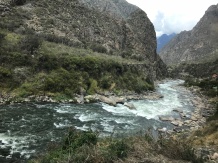Peru’s lack of distinguishable modern architecture is more than made up by its warm and friendly people, their genuine desire to help others, and a long history that does a country proud. Everything seems harder to accomplish here, yet the people are undaunted by physical hardships and challenges.
Cusco lies on a plateau in the highlands, so everything is downhill from there. After adapting to the 11k high altitude in Cusco, each 1K descent towards the 9K Sacred Valley and 8k level at Macchu Picchu feels noticeably easier. I can breathe normally. Not being a mountaineer, I have never focused so much on elevation before. I paid more attention to these stats than to rainfall or temperature in the area!!
We made stops along the way to visit an alpaca/llama (pronounced yama) farm, a weaving group, and a market in Pisac. (See photos above). Our foodies will note the wide array of fruits and vegetables as well as colors–a good sign of healthy eating.
Speaking of colors, Peruvians love bright colors. As demonstrated by the rainbow flag, it represents the people of the highlands. The familiar stripes and ribbons of color seem to aptly reflect the nature and personality of the Peruvian people.
The coca plant is used extensively as a tea to ward off high altitude sickness and one can survive on it alone for five days by chewing the leaf. You drink coca tea here to overcome altitude sickness.
There are over 2500 types of potato grown in Peru of the 3500 varieties known throughout the world. One type has alot of eyes, and as the story goes, if a young girl falls in love with someone, she will tell whether she will marry him by how well she peels one of these potatoes. If she peels it flawlessly, she’ll win her guy, but if she doesn’t….well the eyes will cry the tears for her!
Many of the ruins throughout the Sacred Valley, particularly the fortress at Ollantaytambo, are dress rehearsals for the big Kahuna, Macchu Picchu.The massive sandstones were hewn along the edges to perfection and carved to fit the next/last one as if the stone were extruded from some supersize tube of frosting, only to dry perfectly, without gaps or mortar in place. Hard to believe how these stones were cut, and the ability seem beyond human skills.
A word about the Macchu Picchu buildings from yesterday’s post. There were various ceremonial buildings for offerings to the sun god and others, but an area also served as the King’s residence. Grain was stored in one area, and the extensive terraces were used to grow food.
For more about Macchu Picchu, Hiram Bingham, the man who discovered it, and its origins, go here:
https://en.wikipedia.org/wiki/Machu_Picchu
The other important uses for terracing the mountains was to serve as a system to prevent soil erosion and to collect water from the top to the bottom of the mountain. It’s tempting to compare these to the terraces used in China to grow food, but I’m not sure which came first. In any event, the Peruvian terraces are spectacular just in sheer height and they demonstrate the ingenuity of the Incas and their predecessors.
As I leave Peru after such a short sojourn here, I realize that I may be naive and easily impressed. Nevertheless, the hardships of living in mountainous zones like this make the people sturdy. They live close to and respect nature.
Just a few random snippits about Peru:
Although Spanish is the national language, the second language spoken by people in Cusco is known as Quechua, an ancient and indigenous highland language.
The jungle covers 60 per cent of the country, and the balance is 30% highland and 10% is coastal.
The Inca based in Peru conquered and occupied parts of Argentina, Bolivia, and Ecuador, incl. Santiago, Chile.
Trees do not grow above the alpine level in the highlands, except for the imported eucalyptus from Australia, an invasive but fast growing species. The Macchu Picchu climate is at a lower elevation and has a microclimate more similar to the tropical forest (with orchids, bromeliads and coca plants.
Both Cusco and Macchu Picchu are UNESCO World Heritage Sites and highly recommended.
And for the bus and rail fans out there…here was the interior of the Vistadome Perurail car and a couple of the many spectacular views:

















I’m sold. Now on my priority list f or travel. Thanks for sharing a nd writing about your experience. Look out Rick Steves.
LikeLike